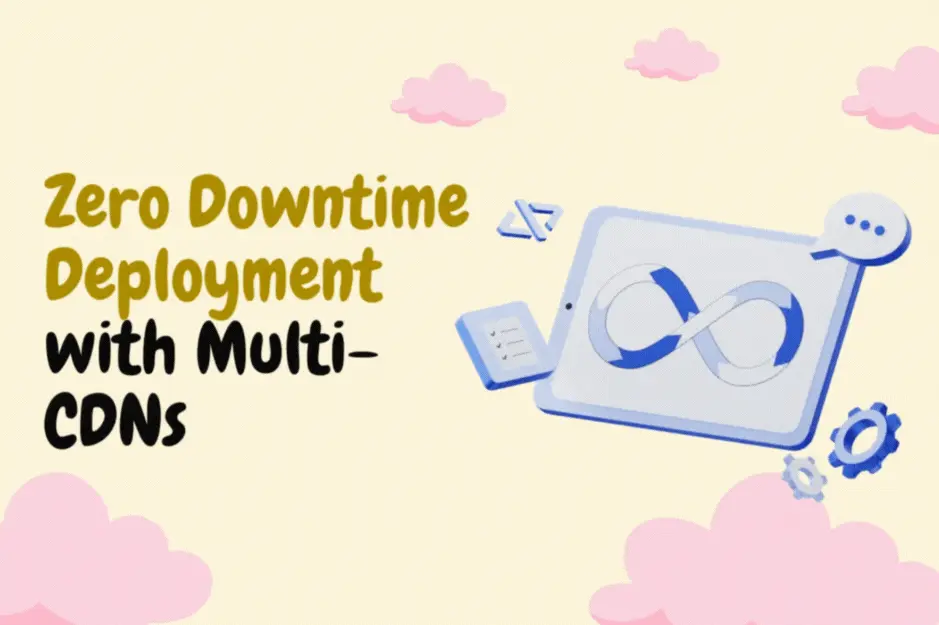Best 6 CDNs for Video Streaming Technology
The world has been on a constant path of progression, yet viewers still have to face the annoyance of buffering, a disruption that can diminish their overall experience. To circumvent this, Content Delivery Networks (CDNs) come to the rescue, enhancing video streaming experiences by efficiently delivering content to users worldwide.

These networks are especially adept at tackling common streaming issues like buffering, ensuring viewers enjoy a smooth and high-quality video experience. But, there are heaps of CDN providers out there, and finding the one that suits your unique needs can be a hassle.
Why Use a CDN for Video Streaming?
CDNs directly reduce buffering, through caching content in multiple geographical locations. This allows them to bring videos closer to the viewer, reducing load times and buffering incidents. This proximity is the reason for a smooth streaming experience, particularly important for high-definition and 4K video content.
Aside from this, CDNs also play a main role in the enhancement of video quality. They manage network traffic effectively, ensuring that high-quality videos are delivered without loss of quality, even during peak usage times. This consistent quality is essential for maintaining viewer engagement and satisfaction, especially in a competitive streaming market.
On top of this, CDNs also offer scalability, a critical aspect for video content providers. They can effortlessly handle sudden spikes in viewer numbers, ensuring that the streaming quality remains unaffected, regardless of the audience size. This scalability is vital for live events or viral content, where viewer numbers can surge unexpectedly.
What to Look for in a CDN?
When choosing the best CDN for video streaming, several key features must be considered to ensure optimal performance:
- Global Coverage: Look for a CDN that offers extensive global coverage with a dense network of servers. This ensures that content is delivered efficiently to viewers worldwide, reducing latency and enhancing the viewing experience.
- Format Support: The CDN should support a wide range of video formats, ensuring compatibility and seamless playback across different devices and platforms.
- Security Measures: Given the value of digital content, the chosen CDN must have robust security features to protect against piracy and unauthorized access. Features like encryption, secure token authentication, and DDoS protection are essential.
- Pricing Models: Cost is a crucial factor. Many CDNs offer pay-as-you-go pricing, allowing for scalability and flexibility in cost management. It’s important to choose a CDN that offers transparent pricing without compromising on quality and features.
- Performance and Reliability: The CDN should have a proven track record of high performance and reliability. This includes consistently fast content delivery and high uptime guarantees.
- Ease of Use and Support: A user-friendly interface and responsive customer support are important, especially for resolving issues quickly and efficiently.
Selecting the right CDN involves balancing these features with your specific video streaming needs to ensure a high-quality viewer experience.
{{promo}}
6 Best CDN Video Streaming Platforms for 2025
In 2025, the CDN landscape has become more competitive than ever! In the heat of this competition, building the best video streaming CDN architecture for your unique needs can be challenging.
While most of the CDN providers offer the same capabilities in varying quality, some tend to make a name for themselves by going that extra mile, ensuring the best for their users:
1. Amazon CloudFront
Amazon CloudFront is deeply integrated with AWS services, offering a powerful combination of scalability, distribution efficiency, and security for video streaming. Its extensive global network ensures low latency and high transfer speeds, crucial for delivering smooth video streams to a global audience.
CloudFront is particularly adept at handling spikes in viewership, thanks to AWS's scalable infrastructure, making it ideal for live streaming events and on-demand video services. Its security features, including AWS Shield for DDoS protection, alongside the capability to tightly control access to video content, ensure that streaming services can maintain both availability and content protection.
This CDN is best suited for businesses seeking a reliable, scalable solution for extensive video libraries and live streaming with the added benefits of integration into the AWS ecosystem.
2. Akamai
Akamai's global CDN network is optimized for speed and reliability, making it an exceptional choice for delivering video content. It stands out for its ability to provide high-quality, adaptive bitrate streaming, ensuring viewers receive the best possible video quality based on their current internet speeds.
Akamai's extensive network ensures content is served from locations close to users, reducing latency and buffering during video streaming. Its solutions are designed to support large-scale live events and high-definition video on demand (VOD), offering features like low-latency streaming and advanced security measures to protect content and users.
Akamai is particularly well-suited for media companies and platforms that require robust, scalable video delivery capabilities to serve a global audience.
3. Fastly
Fastly offers a highly programmable edge cloud platform, making it a strong candidate for video streaming services that require fast, secure, and customizable video content delivery. Its capabilities as one of the best live streaming CDN and video-on-demand providers are enhanced by features like instant purging, real-time analytics, and the ability to push updates quickly.
Fastly's network is designed to reduce latency and improve the loading times of videos, ensuring a smooth streaming experience. Additionally, its focus on security, with features like TLS encryption and DDoS mitigation, protects both content and users.
Fastly is ideal for broadcasters, online learning platforms, and entertainment services that need a flexible, fast CDN capable of supporting dynamic content and interactive experiences.
4. CDNetworks
CDNetworks ensures effective content delivery through its extensive network of over 2,800 Points of Presence (PoPs) worldwide, alongside a strong presence in China.
The platform integrates advanced technologies like AI Super Resolution and Low Bandwidth High Definition (LBHD) to support various content formats and enhance video quality.
With dedicated local support teams, CDNetworks offers 24/7 assistance, providing tailored services that cater to the specific needs of SMEs to OTT platforms, ensuring a robust and reliable streaming experience.
5. Bunny.net
Bunny.net is a lightweight, affordable, and performance-driven CDN designed for fast and reliable video delivery. It provides global edge caching and video streaming capabilities, helping reduce buffering and load times, with its main effective area being Europe.
The Bunny Stream feature simplifies video hosting by handling storage, encoding, and adaptive bitrate playback, eliminating the need for third-party video processors.
With its permanent caching at edge locations, Bunny.net ensures that frequently accessed video files load quickly without repeatedly pulling from the origin server. This makes it a solid choice for content creators and smaller streaming platforms that need low-latency, cost-effective distribution.
6. Gcore
Gcore is a global CDN with a strong focus on low-latency video streaming, making it useful for live broadcasting and high-demand video services.
With 180+ points of presence worldwide, it efficiently delivers content by routing users to the nearest server, reducing buffering and lag. Its AI-based adaptive traffic routing optimizes data flow based on real-time network conditions, preventing congestion and ensuring stable video playback.
Gcore is well-suited for enterprises, gaming platforms, and large-scale broadcasters that need a high-capacity, secure CDN for delivering premium video experiences globally.
Multi-CDN for Video Streaming Technology
This method offers a myriad of benefits, primarily aiming at redundancy and enhanced performance. When using more than one CDN, content providers can ensure higher availability and reliability of their video streams.
In the event one CDN faces outages or performance issues, another can take over, ensuring uninterrupted service to the end users.
1. Redundancy
Redundancy is a critical factor, particularly for high-stakes broadcasting such as live events, where even a momentary disruption can significantly impact viewer satisfaction.
Multi-CDN strategies also cater to global audiences more effectively, as different CDNs may perform better in different geographical regions.
Optimizing the delivery paths of video content enables multi-CDNs to ensure users receive the best possible quality and speed, regardless of their location.
2. Performance
Moreover, a multi-CDN strategy can provide enhanced performance through intelligent load balancing. It dynamically routes user requests to the most efficient CDN, considering factors such as geographic proximity, server load, and network health.
This not only reduces latency and buffering but also accommodates spikes in viewer traffic more adeptly. Performance improvements are further supported by the competition among video CDN providers, encouraging each to maintain optimal service levels to be selected for content delivery.
3. Cost
.gif)
This leads to more favorable contract terms, often enabling cost optimization through real-time traffic management, routing requests to the most cost-effective CDN without compromising on the quality of service.
Conclusion
To sum it all up, choosing the right CDN provider—or combination of providers—is paramount for delivering an optimal video streaming experience. The right CDN can significantly reduce buffering, improve video quality, and ensure content reaches viewers anywhere in the world with minimal latency.
FAQs
- How does a CDN improve video streaming quality?
A CDN reduces latency by caching video files on multiple servers worldwide, ensuring content loads from the closest location instead of a distant origin server.
This minimizes buffering and improves video playback speed. Additionally, CDNs use adaptive bitrate streaming, strategic content distribution to keep caches warm, and optimized delivery methods for a phenomenal viewing experience. - How do CDNs handle sudden spikes in video traffic during live events?
CDNs distribute traffic across multiple edge servers, preventing overload at any single location. They use real-time traffic routing to shift user requests to the best-performing nodes, ensuring stable playback even during viewership surges.
However, scalability isn't always seamless—during major live events, a global CDN facing capacity limits may start serving content from outside the target region, impacting latency and performance. For platforms handling large-scale broadcasts, a multi-CDN strategy helps maintain regional stability and ensures a consistently smooth experience. - How do CDNs support adaptive bitrate streaming for different user connections?
Adaptive bitrate streaming works by encoding multiple versions of a video at different quality levels. The CDN detects the viewer’s internet speed and device capabilities, then serves the best possible resolution.
If the connection weakens, the CDN switches to a lower-quality stream to avoid buffering. When conditions improve, it restores higher-quality playback. For example, in HLS encoding, the user automatically gets their stream resolution adjusted based on their screen size and network conditions. - Who does Netflix use for CDN?
Netflix utilizes its proprietary content delivery network (CDN) called Open Connect. Launched in 2012, Open Connect is designed to deliver Netflix's TV shows and movies efficiently by placing Open Connect Appliances (OCAs) within internet service providers (ISPs) and internet exchange points (IXPs) worldwide.
This approach reduces latency and enhances streaming quality by storing and serving content closer to users. - Which CDN is used by YouTube?
YouTube leverages Google's extensive global network infrastructure for content delivery. In 2022, Google Cloud introduced Media CDN, allowing other media and entertainment companies to utilize the same infrastructure that powers YouTube. Media CDN offers features like adaptive delivery protocols and deep integration with Google Cloud services, providing scalable and reliable streaming experiences.










